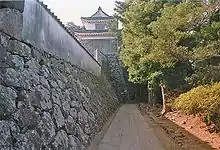Hirado Domain
Hirado Domain (平戸藩, Hirado-han) was a Japanese domain of the Edo period. It is associated with Hizen Province in modern-day Saga Prefecture.[1]
| Hirado Domain 平戸藩 | |
|---|---|
| Domain of Japan | |
| 1587–1871 | |
| Capital | Hirado Castle |
| • Type | Daimyō |
| Historical era | Edo period |
• Established | 1587 |
• Disestablished | 1871 |
| Today part of | Saga Prefecture |

In the han system, Hirado was a political and economic abstraction based on periodic cadastral surveys and projected agricultural yields.[2] In other words, the domain was defined in terms of kokudaka, not land area.[3] This was different from the feudalism of the West.
History
After Toyotomi Hideyoshi’s successful conquest of Kyushu, local warlord Matsura Shigenobu was confirmed in Hirado County, Iki Island and Hario Island to be his domain. During the Japanese invasions of Korea, Hirado was a forward base of operations for Japanese forces. In 1599, Matsura Shigenobu erected a castle called Hinotake-jō on the site of the present-day Hirado Castle. However, he burned the castle down himself in 1613, as a gesture of loyalty towards Shōgun Tokugawa Ieyasu, having served in the losing Toyotomi side during the Battle of Sekigahara. In return, he was allowed to retain his position as daimyō of Hirado Domain under the Tokugawa bakufu.
The present Hirado Castle was constructed in 1704 by order of the 5th daimyō of Hirado domain, Matsura Takashi with the assistance of the Tokugawa shogunate to be the keystone in seaward defenses of Japan in the East China Sea region, now that the country had implemented a policy of national seclusion against western traders and missionaries. Also during the period of Matsura Takashi, a subsidiary domain (Hirado Nitta Domain) of 10,000 koku was created for his younger brother, Matsura Masashi. Matsura Takashi served in a number of important posts in the Tokugawa Shogunate, including that of Jisha-bugyō, a post traditionally reserved only for fudai daimyō. However, his expenses in rebuilding Hirado Castle all but bankrupted the domain.
The 9th daimyō, Matsura Kiyoshi, was a noted essayist and political commentator. The final daimyō, Matsura Akira, commanded his forces as part of the Satchō Alliance during the Boshin War of the Meiji Restoration, in support of Emperor Meiji, and fought at the Battle of Toba–Fushimi and against the Tokugawa remnants of the Ōuetsu Reppan Dōmei in northern Japan, at Morioka and Akita. In April 1884, he was made a count in the new kazoku peerage system. From 1890, he served in the House of Peers of the Diet of Japan. He was later awarded 2nd Court rank.
Territories of the Hirado Domain at the end of the Edo period
It also includes the territory of the Hirado Shinden Domain which was incorporated in 1870.
- Hizen Province :
- Matsuura County : 47 villages
- Sonogi County : 7 villages
- Iki Province :
- Iki County : 11 villages
- Ishida County : 11 villages
List of daimyōs
The hereditary daimyōs were head of the clan and head of the domain.
Name Tenure Courtesy title Court Rank Revenue 1 Matsura Shigenobu (松浦鎮信) 1587–1600 Hizen-no-kami Lower 4th (従四位下) 63,200 koku 2 Matsura Hisanobu (松浦久信) 1600–1602 Hizen-no-kami Lower 5th (従五位下) 63,200 koku 3 Matsura Takanobu (松浦隆信) 1603–1637 Hizen-no-kami Lower 5th (従五位下) 63,200 koku 4 Matsura Shigenobu (松浦鎮信) 1637–1689 Hizen-no-kami Lower 5th (従五位下) 61,700 koku 5 Matsura Takashi (松浦棟) 1689–1713 Hizen-no-kami, Jisha-bugyō Lower 5th (従五位下) 51,700 koku 6 Matsura Atsunobu (松浦篤信) 1713–1727 Hizen-no-kami Lower 5th (従五位下) 51,700 koku 7 Matsura Arinobu (松浦有信) 1727–1728 Hizen-no-kami Lower 5th (従五位下) 51,700 koku 8 Matsura Sanenobu (松浦誠信) 1728–1775 Hizen-no-kami Lower 5th (従五位下) 51,700 koku 9 Matsura Kiyoshi (松浦清) 1775–1806 Iki-no-kami Lower 5th (従五位下) 51,700 koku 10 Matsura Hiromu (松浦熈) 1806–1841 Hizen-no-kami Lower 5th (従五位下) 51,700 koku 11 Matsura Terasu (松浦曜) 1841–1858 Iki-no-kami Lower 5th (従五位下) 51,700 koku 12 Matsura Akira (松浦詮) 1858–1871 Hizen-no-kami 2nd (正二位), Count (伯爵) 61,700 koku
See also
- List of Han
- Abolition of the han system
References

- "Hizen Province" at JapaneseCastleExplorer.com; retrieved 2013-5-28.
- Mass, Jeffrey P. and William B. Hauser. (1987). The Bakufu in Japanese History, p. 150.
- Elison, George and Bardwell L. Smith (1987). Warlords, Artists, & Commoners: Japan in the Sixteenth Century, p. 18.
- Papinot, Jacques Edmond Joseph. (1906). Dictionnaire d’histoire et de géographie du Japon; Papinot, (2003). "Gotō" at Nobiliare du Japon, p. 33; retrieved 2013-6-2.